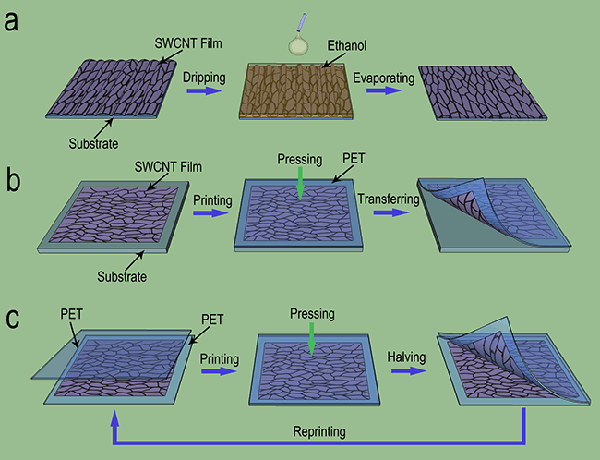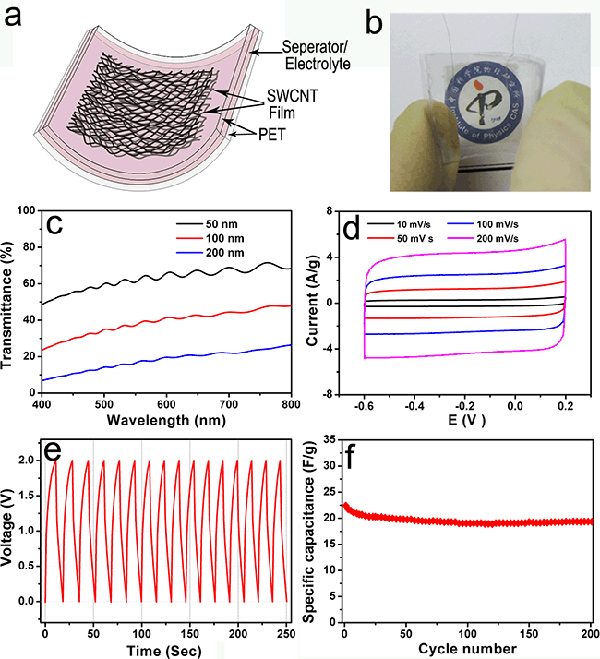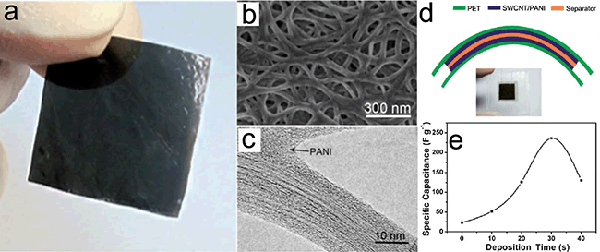As a typical one-dimensional nanomaterial, single-walled carbon nanotubes have many excellent physical and chemical properties due to their unique structures, and have potential applications in mechanics, electronics, optics, and electrochemistry. How to realize the potential application of carbon nanotubes and improve the performance of carbon nanotubes in practical applications are the focus of current researchers.
Institute of Physics, Chinese Academy of Sciences/Beijing National Laboratory for Condensed Matter Physics (CMM) Advanced Materials and Structure Analysis Laboratory “Nanomaterials and Mesoscopic Physics†team has been working on the preparation, properties, and applications of carbon nanotube films for many years. A series of results (Adv. Mater. 2009, 21, 603; Nano Lett. 2009, 9, 2855; Nanoscale 2011, 3, 3731; Nano Lett. 2011, 11, 4636; Energ. Environ. Sci. 2011, 4 , 1440). Recently, the research group Dr. Niu Zhiqiang, researcher Zhou Wei, academician Si Sishen, etc. and Dr. Feng Guoxing, Research Fellow Li Yan, Research Fellow Hu Yongsheng, Institute of Clean Energy Laboratory Huang Xuejie, Professor Chen Xiaodong, School of Materials Science and Engineering, Nanyang Technological University, Singapore, and University of Wollongong, Australia Dr. Chen Jun of Intelligent Polymer Research Institute cooperated to fully utilize the unique continuous network structure of self-supporting flexible carbon nanotube films grown directly, high electrical conductivity, high mechanical strength, high light transmittance, and other characteristics to study such carbon nanotubes. Thin film applications in energy storage devices and transparent flexible electronics.
The carbon nanotube transparent film is an ideal material to replace the indium tin oxide (ITO) conductive film, and more importantly, it is expected to be widely applied to flexible electronic devices. The self-supporting carbon nanotube films directly prepared by the floating catalyst method have a unique two-dimensional continuous network structure, and thus have excellent electrical and mechanical properties (Nano. Lett. 2007, 7, 2307). However, due to the constraints of its preparation conditions, self-supporting transparent conductive films smaller than 100 nm are difficult to obtain directly by this method, which limits its further application. In order to solve this problem, they developed a traditional transfer printing technology and proposed a thinning method for carbon nanotube films based on electrostatic adsorption—a repeated transfer printing method, which uses the electrostatic adsorption effect of ions to improve the low surface energy substrates. The surface energy enables the transfer of carbon nanotube films from a high surface energy substrate to a substrate with a lower surface energy.
Combining a carbon nanotube film with a special two-dimensional network structure and an electrostatic adsorption repeated transfer printing method, ultrathin carbon nanotube films with different thicknesses or even sub-monolayers can be obtained on a PET substrate, and the transparency can be more than 90%. This method can not only effectively improve the utilization of carbon nanotubes, maintain the structure of carbon nanotube films, but also can effectively improve the preparation efficiency of ultrathin carbon nanotube films and simplify the experimental process. This method is applying for a Chinese invention patent (201210270061.0). Based on the prepared ultrathin carbon nanotube film, the researchers assembled a flexible transparent carbon nanotube film supercapacitor, and the supercapacitor showed a certain light transmittance and good electrochemical performance. The results of the relevant studies were published in Small (DOI: 10.1002/smll.201201587) and were highly evaluated by editors.
The carbon nanotube film has a high conductivity and a porous structure and can be directly used as an electrode material of the super capacitor. However, since the carbon nanotubes in the carbon nanotube film are generally in the form of tube bundles, the internal void size of the tube bundle is below 0.4 nm, and the electrolysis is performed. The liquid ions cannot enter the voids inside the tube bundle at all, so the surface of the carbon nanotubes inside the tube bundle does not contribute to the electric double layer capacitance, resulting in a significant reduction in the effective specific surface area and a smaller specific capacitance. The coating of conductive polymers on the surface of carbon nanotubes and the introduction of tantalum capacitors are an effective way to increase the specific capacitance of carbon nanotube electrodes. However, the addition of a low-conductivity conductive polymer leads to a significant decrease in the conductivity of the carbon nanotube/conductive polymer heterostructure electrode compared to carbon nanotubes, affecting the power density of the supercapacitor.
How to use the conductive polymer to increase the energy density without reducing the power density of the supercapacitor is a problem in the preparation of the carbon nanotube/conductive polymer heteroelectrode. Using a self-supporting carbon nanotube film grown directly as a template, they successfully fabricated "skeleton/skin" type carbon nanotube/polyaniline heterostructure films by electrodeposition. In this heterostructure film, polyaniline uniformly coats carbon nanotube bundles in the carbon nanotube film, and the carbon tube bundle still maintains a good continuous network structure, forming a new “skeleton/skin†type carbon nanotube/polyaniline. The heterogeneous continuous mesh structure ensures that the heterostructure film has high conductivity. This structure not only gives full play to the high conductivity of carbon nanotubes, but also takes advantage of the conductive polymer tantalum capacitors.
The independent unsupported carbon nanotube/polyaniline heterostructure film has very good mechanical properties and can be used as a flexible supercapacitor electrode. Compared with the directly grown carbon nanotube film electrode, the specific capacitance of the supercapacitor electrode based on the carbon nanotube/polyaniline heterostructure film is improved by nearly one order of magnitude, and the current density of the electrode is also increased, and it is also guaranteed to have a comparative advantage. High power density. The relevant research results were published in Energy & Environmental Science (2012, 5, 8726) and were selected by the editorial department as Hot Paper. Chemistry World also reported specifically on Skeleton and skin strategy improving supercapacitor.
The above work was supported by the National Natural Science Foundation of China, the Ministry of Science and Technology, the Chinese Academy of Sciences and the Beijing Municipal Education Commission.

Fig. 1 Schematic diagram of thinning process of carbon nanotube film. (a) Schematic diagram of the smoothing process of the carbon nanotube film; (b) Transferring the carbon nanotube film from the substrate to the PET process using the transfer printing method; (c) A schematic diagram of the process of thinning the carbon nanotube film by repeated transfer printing.

Fig. 2 (a) Schematic diagram of transparent supercapacitor and (b) Optical photo; (c) Transmittance of supercapacitors assembled with different thickness of carbon nanotube films, flexible transparent carbon nanotube thin film supercapacitor (50 nm) (d) CV curves at different scan rates; (e) Constant current charge and discharge curves; (f) Specific capacitance changes with charge and discharge times.

Figure 3 (a) Optical photographs of ultra-thin carbon nanotube/polyaniline heterostructure films; (b) SEM images and (c) TEM images; (d) schematic and optical photographs of flexible transparent carbon nanotube supercapacitors; ( e) Deposition of polyaniline at different times Mass/capacitance of carbon nanotube/polyaniline thin film supercapacitor electrodes.
Chopping Board,Granite Chopping Board,Rectangular Chopping Board,Color Chopping Board
Stone Kitchenware Co., Ltd. , http://www.enamel-cookware.com